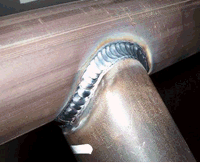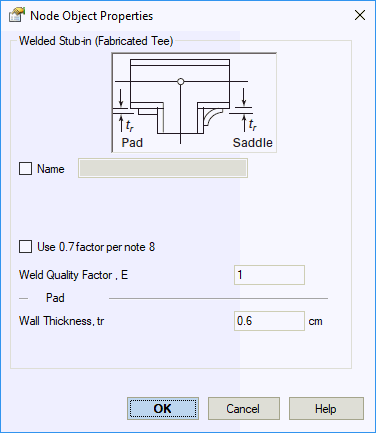



1 - reinforcement pad, 2 - matching pipe, 3 - header pipe
A stub-in is a T-shaped joint with the same cross-section as adjoining elements. Branch and header axes are perpendicular. All properties are automatically determined from adjoining elements.

Property |
Description |
Name |
Element name. If checked then it shown in 3D view |
Branch not perpendicular to header |
If checked, branch and header joint angle is not checked and analysis is header as for a slanted stub-in (according to GOST R 55596-2013 and RD 10-249-98). If not checked, branch and header joint is checked and if it is not equal to 90 degrees, an error is displayed. |
Longitudinal Weld Joint Efficiency Factor, E |
Longitudinal weld joint efficiency factor, E. More... |
Manufacturing technology |
For ASME B31.1, ASME B31.3, DL/T 5366-2014 seamless pipe will always use Wl=1.0. For electric-welded pipe Wl will be specified from database. More... When using GOST 32388-2013, pipe physical properties are taken from different materials databases depending on pipe type (seamless/welded). |
Use notes 6,9,10 |
Should be checked if number of displacement cycles exceeds 200
|
Meet D1, Note 10 a,c,d,e,f |
|
Use 0.7 factor per note 8 |
ASME B31J-2017 code requirement
|
Pad thickness, tr (Sn) |
Pad thickness |
Pad width, bn |
Pad width |
Refresh SIF and k using FEA |
|
SIF |
To insert an element, select the desired node and use the menu option: Insert > Tee > Stub-in
To view properties of an existing element:
Double-click the element in the 3D view
Select the
element and press the  toolbar icon
toolbar icon